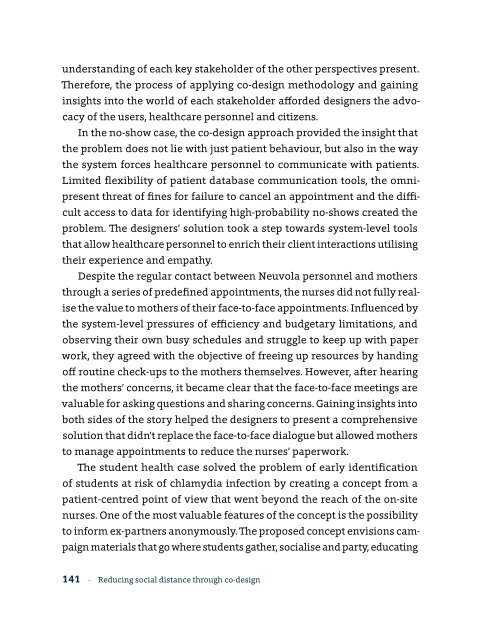Designing for wellbeing
Designing for wellbeing
Designing for wellbeing
You also want an ePaper? Increase the reach of your titles
YUMPU automatically turns print PDFs into web optimized ePapers that Google loves.
understanding of each key stakeholder of the other perspectives present.<br />
There<strong>for</strong>e, the process of applying co-design methodology and gaining<br />
insights into the world of each stakeholder af<strong>for</strong>ded designers the advocacy<br />
of the users, healthcare personnel and citizens.<br />
In the no-show case, the co-design approach provided the insight that<br />
the problem does not lie with just patient behaviour, but also in the way<br />
the system <strong>for</strong>ces healthcare personnel to communicate with patients.<br />
Limited flexibility of patient database communication tools, the omnipresent<br />
threat of fines <strong>for</strong> failure to cancel an appointment and the difficult<br />
access to data <strong>for</strong> identifying high-probability no-shows created the<br />
problem. The designers’ solution took a step towards system-level tools<br />
that allow healthcare personnel to enrich their client interactions utilising<br />
their experience and empathy.<br />
Despite the regular contact between Neuvola personnel and mothers<br />
through a series of predefined appointments, the nurses did not fully realise<br />
the value to mothers of their face-to-face appointments. Influenced by<br />
the system-level pressures of efficiency and budgetary limitations, and<br />
observing their own busy schedules and struggle to keep up with paper<br />
work, they agreed with the objective of freeing up resources by handing<br />
off routine check-ups to the mothers themselves. However, after hearing<br />
the mothers’ concerns, it became clear that the face-to-face meetings are<br />
valuable <strong>for</strong> asking questions and sharing concerns. Gaining insights into<br />
both sides of the story helped the designers to present a comprehensive<br />
solution that didn’t replace the face-to-face dialogue but allowed mothers<br />
to manage appointments to reduce the nurses’ paperwork.<br />
The student health case solved the problem of early identification<br />
of students at risk of chlamydia infection by creating a concept from a<br />
patient-centred point of view that went beyond the reach of the on-site<br />
nurses. One of the most valuable features of the concept is the possibility<br />
to in<strong>for</strong>m ex-partners anonymously. The proposed concept envisions campaign<br />
materials that go where students gather, socialise and party, educating<br />
141 · Reducing social distance through co-design
















